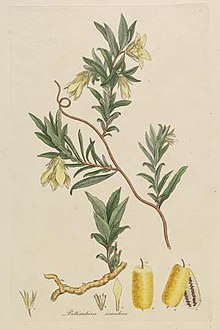A specimen of the botany of New Holland/Billardiera scandens

Petals five, alternate with the leaves of the calyx. Nectary none. Stigma simple. Berry superior, with many seeds.
Flower-stalks solitary, single-flowered. Leaves somewhat hairy.
AMID all the beauty and variety which the vegetable productions of New Holland display in such profusion, there has not yet been discovered a proportionable degree of usefulness to mankind, at least with respect to food. This is our first and most natural enquiry in a scene of such novelty; but it is an enquiry natural to all the lower orders of sensible beings, as well as to man. It may perhaps mortify his pride to think how much more quickly and certainly inferior animals judge upon such a subject. Their powers however reach no farther. It is the peculiar privilege of reasoning man, not only to extend his enquiries to a multiplicity of attainable benefits to himself and his species, besides the mere animal necessity of food, but also to walk with God through the garden of creation, and be initiated into the different plants of his providence in the construction and œconomy of all these various beings; to study their dependencies upon one another in an infinitely complex chain, every link of which is essential; and to trace out all those various uses and benefits to every branch of the animal creation, of which each animal is a judge only for himself. In this point of view no natural production is beneath the notice of the philosopher, nor any enquiry trifling under the guidance of a scientific mind.
In compliance however with those who do not look so deep into natural knowledge, we here introduce to their acquaintance almost the only wild eatable fruit of the country we are about to illustrate. It may serve as an olive-branch, to procure their patience as we proceed together hereafter through the consideration of less conspicuously interesting objects. Nor will the scientific botanist find the plant before us unworthy of his most accurate attention.
Its genus is easily characterised in the Linnæan system by the many-seeded berry above the flower, and may stand somewhere between Escallonia and Mangifera. We cannot certainly tell what genera are its natural allies, especially as we have no knowledge of the fruit and seeds except from a drawing. May it be akin to the Capparides of M. de. Jussieu?
The name Billardiera is given it in honour of James Julian la Billardiere, M.D. F.M.L.S. now engaged as botanist on board the French ships sent in search of M. de la Peyrouse. His Icones Plantarum Syriæ rariorum, the fruits of a journey to the Levant in 1786, justly entitle him to such a distinction.
We have acquired two species of this genus from New South Wales. The root of the present is woody and zigzag, with a reddish inner bark. Stems several, twining among other shrubs, branched, woody, round, downy when young, destitute of leaves except on the young branches. Leaves alternate, sessile, lanceolate, bluntish, mostly entire, but undulated and revolute in such a manner as to appear dentated, which they sometimes really are, paler beneath, slightly veined, most hairy when young. Stipulæ none. Flowers solitary, enveloped in long leaves, terminating the young branches, on short downy footstalks, drooping, of a pale lemon-colour, without bracteæ. Calyx regular, of five equal, narrow, pointed, leaves, hairy and ciliated. Petals five, twice as long, equal, lanceolate, pointed, attenuated at the base, inserted into the receptacle. Stamina five, as long as the calyx, and opposite to it, equal, subulate, smooth. Antheræ arrow-shaped. Germen altogether superior, oblong, very hairy. Style short, erect. Stigma simple. Berry cylindrical, yellow, very obtuse at both ends, downy, terminated by the permanent style, and said to have a very fine flavour, not unlike a roasted apple. Seeds numerous, horizontal, blackish.
EXPLANATION of TAB. I.
1. Calyx. 2. A Petal. 3. Stamina and Pistillum. 4, 4. Ripe Fruit. 5, 5. Footstalks. 6. Seeds.
